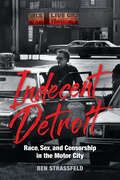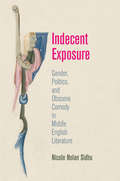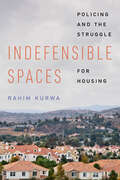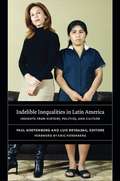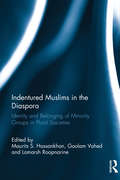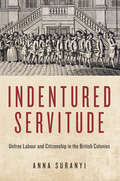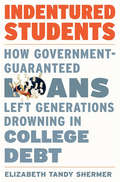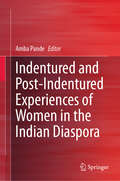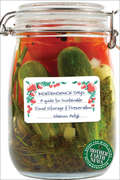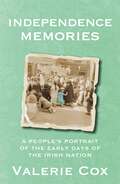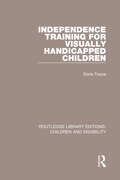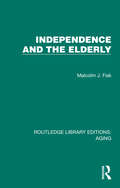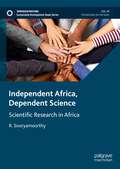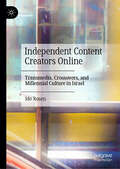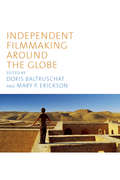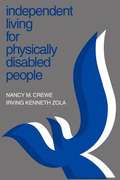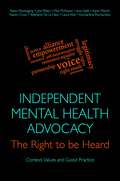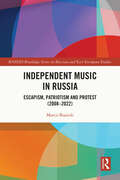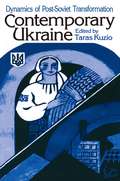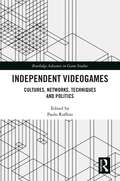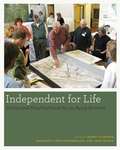- Table View
- List View
Indecent Detroit: Race, Sex, and Censorship in the Motor City
by Ben StrassfeldWhile Detroit has been a major focus in urban history, little has been written on censorship in the very city that—due to shifting legalities, the urban crisis, and racial tensions—profoundly shaped media suppression in the United States. By examining censorship in film and literature, Indecent Detroit recounts the evolution of media control from the end of WWII through the 1970s, when the US saw a major change in the legal mechanisms used to censor media due to court rulings that curtailed censorship laws. Ben Strassfeld reveals how Detroit altered its censorial tactics and rhetoric from an obscenity-based system of censorship centered in the Detroit Police Department to a regulatory model based in zoning law that was then expanded nationwide. This shift was connected to broader social and political trends, including the sexual revolution, that led the public to increasingly turn against censorship. A must-read for film and media scholars, Indecent Detroit highlights how one Midwest city's ordinance was imitated across the country after it was upheld by the US Supreme Court, making this more than a local curiosity but also an influential model for the cultural, political, and moral control of urban space through media regulation.
Indecent Exposure: Gender, Politics, and Obscene Comedy in Middle English Literature (The Middle Ages Series)
by Nicole Nolan SidhuMen and women struggling for control of marriage and sexuality; narratives that focus on trickery, theft, and adultery; descriptions of sexual activities and body parts, the mention of which is prohibited in polite society: such are the elements that constitute what Nicole Nolan Sidhu calls a medieval discourse of obscene comedy, in which a particular way of thinking about men, women, and household organization crosses genres, forms, and languages. Inviting its audiences to laugh at violations of what is good, decent, and seemly, obscene comedy manifests a semiotic instability that at once supports established hierarchies and delights in overturning them.In Indecent Exposure, Sidhu explores the varied functions of obscene comedy in the literary and visual culture of fourteenth- and fifteenth-century England. In chapters that examine Chaucer's Reeve's Tale and Legend of Good Women; Langland's Piers Plowman; Lydgate's Mumming at Hertford, Troy Book, and Fall of Princes; the Book of Margery Kempe, the Wakefield "Second Shepherds' Play"; the Towneley "Noah"; and other works of drama, Sidhu proposes that Middle English writers use obscene comedy in predictable and unpredictable contexts to grapple with the disturbances that English society experienced in the century and a half following the Black Death. For Sidhu, obscene comedy emerges as a discourse through which writers could address not only issues of gender, sexuality, and marriage but also concerns as varied as the conflicts between Christian doctrine and lived experience, the exercise of free will, the social consequences of violence, and the nature of good government.
Indefensible Spaces: Policing and the Struggle for Housing
by Rahim KurwaA free ebook version of this title is available through Luminos, University of California Press’s Open Access publishing program. Visit www.luminosoa.org to learn more.Indefensible Spaces examines the policing of housing through the story of Black community building in the Antelope Valley, Los Angeles County's northernmost outpost. Tracing its evolution from a segregated postwar suburb to a destination for those priced, policed, and evicted out of Los Angeles, Rahim Kurwa tells the story of how the Antelope Valley resisted Black migration through the policing of subsidized housing—and how Black tenants and organizers fought back. This book sheds light on how the nation's policing and housing crises intersect, offering powerful lessons for achieving housing justice across the country.
Indelible Inequalities in Latin America: Insights from History, Politics, and Culture
by Paul Gootenberg Luis ReygadasSince the earliest years of European colonialism, Latin America has been a region of seemingly intractable inequalities, marked by a stark divide between the haves and the have-nots. This collection illuminates the diverse processes that have combined to produce and reproduce inequalities in Latin America, as well as some of the implications of those processes for North Americans. Anthropologists, cultural critics, historians, and political scientists from North and South America offer new and varied perspectives, building on the sociologist Charles Tilly's relational framework for understanding enduring inequalities. While one essay is a broad yet nuanced analysis of Latin American inequality and its persistence, another is a fine-grained ethnographic view of everyday life and aspirations among shantytown residents living on the outskirts of Lima. Other essays address topics such as the initial bifurcation of Peru's healthcare system into one for urban workers and another for the rural poor, the asymmetrical distribution of political information in Brazil, and an evolving Cuban "aesthetics of inequality," which incorporates hip-hop and other transnational cultural currents. Exploring the dilemmas of Latin American inequalities as they are playing out in the United States, a contributor looks at new immigrant Mexican farmworkers in upstate New York to show how undocumented workers become a vulnerable rural underclass. Taken together, the essays extend social inequality critiques in important new directions. Contributors Jeanine Anderson Javier Auyero Odette Casamayor Christina Ewig Paul Gootenberg Margaret Gray Eric Hershberg Lucio Renno Luis Reygadas
Indentured Muslims in the Diaspora: Identity and Belonging of Minority Groups in Plural Societies
by Goolam Vahed Lomarsh Roopnarine Maurits S. HassankhanThis is the fourth publication originating from the conference Legacy of Slavery and Indentured Labour: Past, Present and Future, which was organised in June 2013 by the Institute of Graduate Studies and Research (IGSR), Anton de Kom University of Suriname. The core of the book is based on a conference panel which focused specifically on the experience of Muslim with indentured migrants and their descendants. This is a significant contribution since the focus of most studies on Indian indenture has been almost exclusively on Hindu religion and culture, even though an estimated seventeen percent of migrants were Muslims. This book thus fills an important gap in the indentured historiography, both to understand that past as well as to make sense of the present, when Muslim identities are undergoing rapid changes in response to both local and global realities. The book includes a chapter on the experiences of Muslim indentured immigrants of Indonesian descent who settled in Suriname. The core questions in the study are as follows: What role did Islam play in the lives of (Indian) Muslim migrants in their new settings during indenture and in the post-indenture period? How did Islam help migrants adapt and acculturate to their new environment? What have been the similarities and differences in practices, traditions and beliefs between Muslim communities in the different countries and between them and the country of origin? How have Islamic practices and Muslim identities transformed over time? What role does Islam play in the Muslims’ lives in these countries in the contemporary period? In order to respond to these questions, this book examines the historic place of Islam in migrants’ place of origin and provides a series of case studies that focus on the various countries to which the indentured Indians migrated, such as Mauritius, South Africa, Guyana, Trinidad, Suriname and Fiji, to understand the institutionalisation of Islam in these settings and the actual lived experience of Muslims which is culturally and historically specific, bound by the circumstances of individuals’ location in time and space. The chapters in this volume also provide a snapshot of the diversity and similarity of lived Muslim experiences.
Indentured Servitude: Unfree Labour and Citizenship in the British Colonies (States, People, and the History of Social Change)
by Anna SuranyiHundreds of thousands of British and Irish men, women, and children crossed the Atlantic during the seventeenth century as indentured servants. Many had agreed to serve for four years, but large numbers had been trafficked or “spirited away” or were sent forcibly by government agencies as criminals, political rebels, or destitute vagrants.In Indentured Servitude Anna Suranyi provides new insight into the lives of these people. The British government, Suranyi argues, profited by supplying labour for the colonies, removing unwanted populations, and reducing incarceration costs within Britain. In addition, it was believed that indigents, especially destitute children, benefited morally from being placed in indenture. Capitalist entrepreneurs who were influential at the highest levels of government made their fortunes from Atlantic trade in goods, indentured servants, and slaves, and their participation in the servant trade contributed to the commercialization of criminal justice. Suranyi breaks new ground in showing how indentured servitude was challenged: once in the colonies, indentured servants adapted resourcefully to their circumstances and rebelled against unfair conditions and abuse by suing their masters, by running away, or through outright revolt.Emerging ideas about race and citizenship led to vehement public debate about the conditions of indentured servants and the ethics of indenture itself, prompting legislation that aimed to curb the worst excesses while slavery continued to expand unchecked.
Indentured Students: How Government-Guaranteed Loans Left Generations Drowning in College Debt
by Elizabeth Tandy ShermerThe untold history of how America’s student-loan program turned the pursuit of higher education into a pathway to poverty. It didn’t always take thirty years to pay off the cost of a bachelor’s degree. Elizabeth Tandy Shermer untangles the history that brought us here and discovers that the story of skyrocketing college debt is not merely one of good intentions gone wrong. In fact, the federal student loan program was never supposed to make college affordable. The earliest federal proposals for college affordability sought to replace tuition with taxpayer funding of institutions. But Southern whites feared that lower costs would undermine segregation, Catholic colleges objected to state support of secular institutions, professors worried that federal dollars would come with regulations hindering academic freedom, and elite-university presidents recoiled at the idea of mass higher education. Cold War congressional fights eventually made access more important than affordability. Rather than freeing colleges from their dependence on tuition, the government created a loan instrument that made college accessible in the short term but even costlier in the long term by charging an interest penalty only to needy students. In the mid-1960s, as bankers wavered over the prospect of uncollected debt, Congress backstopped the loans, provoking runaway inflation in college tuition and resulting in immense lender profits. Today 45 million Americans owe more than $1.5 trillion in college debt, with the burdens falling disproportionately on borrowers of color, particularly women. Reformers, meanwhile, have been frustrated by colleges and lenders too rich and powerful to contain. Indentured Students makes clear that these are not unforeseen consequences. The federal student loan system is working as designed.
Indentured and Post-Indentured Experiences of Women in the Indian Diaspora
by Amba PandeThis book describes the processes of migration and settlement of indentured Indian women and tries to map their struggles, challenges and agencies. It highlights the fact that even though indentured women faced various kinds of violence and abuse owing to the authoritarian and patriarchal setup of the plantations, over a period of time, they managed to turn the adverse circumstances to their advantage. They struggled to emerge as productive workforces and empowered themselves through acquiring education and skill, and negotiating new spaces and identities for themselves. At the same time, they also raised families in often inhospitable circumstances, passing on to their descendants, a strong foundation to build successful lives for themselves.The book discusses indentured women from a multidisciplinary perspective and adopts multiple methodologies, including primary and secondary sources, personal narrations, pictorial representations and theoretical discussions. It also provides an overview of the current discourses and the changing paradigms of the studies on Indian indentured women. Further, it presents a detailed, region-wise description of indentured women migrants. The regions covered in this book are Asia- Pacific (countries covered are Fiji, Burma and Nepal); Africa (countries covered are South Africa, Mauritius and Reunion Island); and the Caribbean (countries covered are Suriname, Trinidad and Tobago). In addition, one full section of the book is devoted to the theoretical frameworks that touch upon gender performativity, normative misogyny, Bahadur's Coolie Women, literary representations and resistance movements. It is intended for academics and researches in the field of diaspora/migration/transnational studies, history, sociology, literature, women/gender studies, as well as policymakers and general readers interested in the personal experiences of women and migrants.
Independence Days: A Guide to Sustainable Food Storage & Preservation (Mother Earth News Books for Wiser Living)
by Sharon Astyk&“Be warned! Independence Days will change the way you eat. It is not just a guide for storing food but a manual for living in a changing world.&” —Kathy Harrison, author of Prepping 101 Hard times aren&’t just coming, they are here already. The recent economic collapse has seen millions of North Americans move from the middle class to being poor, and from poor to hungry. At the same time, the idea of eating locally is shifting from being a fringe activity for those who can afford it to an essential element of getting by. But aside from the locavores and slow foodies, who really knows how to eat outside of the supermarket and out of season? And who knows how to eat a diet based on easily stored and home preserved foods? Independence Days tackles both the nuts and bolts of food preservation, as well as the host of broader issues tied to the creation of local diets. It includes: · How to buy in bulk and store food on the cheap · Techniques, from canning to dehydrating · Tools—what you need and what you don&’t In addition, it focuses on how to live on a pantry diet year-round, how to preserve food on a community scale, and how to reduce reliance on industrial agriculture by creating vibrant local economies. Better food, plentiful food, at a lower cost and with less energy expended: Independence Days is for all who want to build a sustainable food system and keep eating—even in hard times. &“[Astyk] builds a sturdy path to a full larder, a safe family, and a more secure community.&” —Robin Wheeler, author of Food Security for the Faint of Heart
Independence Memories: A People’s Portrait of the Early Days of the Irish Nation
by Valerie CoxA PEOPLE'S PORTRAIT OF A PERIOD OF MOMENTOUS CHANGE IN IRISH HISTORY.Independence Memories is a fascinating social history, from living and inherited memory, of the period surrounding Irish Independence and the Civil War.It was a time of violence, of death, of emigration, of families divided into pro- and anti-Treaty, Michael Collins and Eamon de Valera. Against a tapestry of safe houses and mountain hide outs, people fell in love, raised families and laid the foundations of the country we live in now.We read the story of Galwayman Michael Feerick, who rode his white horse through the streets of Dunmore, shouting 'blackguards' at the Black and Tans. We meet the two Mollys, Dublin street traders and runners for Michael Collins, who sewed bullets into the hems of their long skirts.We relive the attack by the Black and Tans on the home of gamekeeper John Vahey and we hear from the Kavanagh family who were offered £1 for every year of the life of their 19-year-old daughter, Mary Ellen, shot dead in Buncrana.And, memorably, 107-year-old Máirín Hughes shares fascinating recollections of being kept in school in Killarney when there was an attack on the RIC barracks down the road. A wonderful compendium of stories and memories by Ireland's oldest citizens, from the much-loved author of Growing Up With Ireland.
Independence Memories: A People’s Portrait of the Early Days of the Irish Nation
by Valerie CoxA PEOPLE'S PORTRAIT OF A PERIOD OF MOMENTOUS CHANGE IN IRISH HISTORY.Independence Memories is a fascinating social history, from living and inherited memory, of the period surrounding Irish Independence and the Civil War.It was a time of violence, of death, of emigration, of families divided into pro- and anti-Treaty, Michael Collins and Eamon de Valera. Against a tapestry of safe houses and mountain hide outs, people fell in love, raised families and laid the foundations of the country we live in now.We read the story of Galwayman Michael Feerick, who rode his white horse through the streets of Dunmore, shouting 'blackguards' at the Black and Tans. We meet the two Mollys, Dublin street traders and runners for Michael Collins, who sewed bullets into the hems of their long skirts.We relive the attack by the Black and Tans on the home of gamekeeper John Vahey and we hear from the Kavanagh family who were offered £1 for every year of the life of their 19-year-old daughter, Mary Ellen, shot dead in Buncrana.And, memorably, 107-year-old Máirín Hughes shares fascinating recollections of being kept in school in Killarney when there was an attack on the RIC barracks down the road. A wonderful compendium of stories and memories by Ireland's oldest citizens, from the much-loved author of Growing Up With Ireland.
Independence Memories: A People’s Portrait of the Early Days of the Irish Nation
by Valerie CoxA PEOPLE'S PORTRAIT OF A PERIOD OF MOMENTOUS CHANGE IN IRISH HISTORY.Independence Memories is a fascinating social history, from living and inherited memory, of the period surrounding Irish Independence and the Civil War.It was a time of violence, of death, of emigration, of families divided into pro- and anti-Treaty, Michael Collins and Eamon de Valera. Against a tapestry of safe houses and mountain hide outs, people fell in love, raised families and laid the foundations of the country we live in now.We read the story of Galwayman Michael Feerick, who rode his white horse through the streets of Dunmore, shouting 'blackguards' at the Black and Tans. We meet the two Mollys, Dublin street traders and runners for Michael Collins, who sewed bullets into the hems of their long skirts.We relive the attack by the Black and Tans on the home of gamekeeper John Vahey and we hear from the Kavanagh family who were offered £1 for every year of the life of their 19-year-old daughter, Mary Ellen, shot dead in Buncrana.And, memorably, 107-year-old Máirín Hughes shares fascinating recollections of being kept in school in Killarney when there was an attack on the RIC barracks down the road. A wonderful compendium of stories and memories by Ireland's oldest citizens, from the much-loved author of Growing Up With Ireland.
Independence Training for Visually Handicapped Children
by Doris ToozeFirst published in 1981, this book was written to help parents and teachers to participate in child-based mobility programmes, covering the needs of visually-handicapped children from pre-school to adulthood. It gives insight into ways in which these figures can make the world meaningful to young children, as well as making them aware of the special training that is necessary to develop the social skills of daily living that a sighted child acquires through imitation. Travel techniques must be learnt to enable these children to move independently and the book describes various methods that can be used by the blind traveller. It also examines the role of physical education and dance, both of particular importance for the visually-handicapped child at school age.
Independence and the Elderly (Routledge Library Editions: Aging)
by Malcolm J. FiskIn the 1980s much research into the needs of the elderly was undertaken from the perspective of a ‘sickness’ model, a model which reinforced labels of elderly people as frail, disabled, dependent and economically unproductive. Few studies adopted a positive attitude to ageing and elderly people.Originally published in 1986, reissued here with a new preface, this book helped to redress this imbalance by focusing on the theme of independence, examined particularly from the perspective of current housing and social policies relating to elderly people at the time. The author looks at sheltered housing in detail, including discussion of alarm systems, ‘staying put’ schemes and residential homes. The book was essential reading for academics and practitioners in the health and social welfare fields with a concern for the elderly and the ways in which they could retain a meaningful independence.
Independence of the Scottish Mind
by Gerry HassanThis study explores modern Scotland and examines how Scottish politics, culture and identities have interacted within the national and international contexts in the last 30 years. It considers which voices and opinions have proven influential and defining, and it charts the boundaries of public conversation to and beyond the independence referendum. This book locates contemporary debates on Scottish self-government in an analysis of the long term historic development of Scottish autonomy and difference. Based on extensive interviews with leading members of the Scottish political commentariat, it applies the idea of "elite narratives" to articulate how ideas and debate can slowly shift and frame public opinion. It draws on ideas of the construction of the near-past, folklore, collective memories, power, voice and space, to bring together an original contribution to politics, media and the dynamics of public debate.
Independent Africa, Dependent Science: Scientific Research in Africa (Sustainable Development Goals Series)
by R. SooryamoorthyThis book offers an examination of Africa’s scientific landscape based on extensive empirical data encompassing fifty-four African countries. It traces the evolution of science on the continent, highlighting research areas, global partnerships, funding sources, research capacity, and the impact of science policies. Acknowledging that Africa relies heavily on external sources, particularly from the Global North, for scientific research, the book identifies and addresses obstacles hindering self-reliance and underscores the urgent need for revitalized partnerships and cooperation to bolster Africa's scientific autonomy. It offers valuable recommendations to promote self-reliance, making it an indispensable resource for scholars, policymakers, and practitioners.
Independent Content Creators Online: Transmedia, Crossovers, and Millennial Culture in Israel
by Ido RosenThis book analyses popular works by the first generation of Israeli independent content creators who gained their reputation by achieving viral success on social media. Some of them paved their way from the web to mainstream culture, yet so far, their fascinating innovations have not been researched. This pioneering book makes an important advancement in filling this gap, by discussing cross-over and transnationalism. It addresses, among others, issues of temporality, ideology, ontology, aesthetics, industry and commerce, humor, and stardom.
Independent Filmmaking Around the Globe
by Mary P. Erickson Doris BaltruschatIndependent Filmmaking around the Globe calls attention to the significant changes taking place in independent cinema today, as new production and distribution technology and shifting social dynamics make it more and more possible for independent filmmakers to produce films outside both the mainstream global film industry and their own national film systems. Identifying and analyzing the many complex forces that shape the production and distribution of feature films, the authors detail how independent filmmakers create work that reflects independent voices and challenges political, economic, and cultural constraints.With chapters on the under-explored cinemas of Greece, Turkey, Iraq, China, Malaysia, Peru, and West Africa, as well as traditional production centres such as the United States, the United Kingdom, Canada, and Australia, Independent Filmmaking around the Globe explores how contemporary independent filmmaking increasingly defines the global cinema of our time.
Independent Living for Physically Disabled People
by Irving Kenneth Zola Nancy M. CreweA text book for students in Rehabilitation Counseling classes.
Independent Mental Health Advocacy - The Right to Be Heard: Context, Values and Good Practice
by Karen Newbigging Konstantina Poursanidou Karen Machin Toby Brandon Stephanie De Haye Julie Ridley Laura Able Mick Mckeown Kaaren Cruse June Sadd Kris ChasteyIndependent mental health advocacy is a crucial means of ensuring rights and entitlements for people sectioned under the Mental Health Act. This book takes an appreciative but critical view of independent mental health advocacy, locating the recent introduction of Independent Mental Health Advocates (IMHAs) within a broader historical, social and policy context, and anticipates future developments. The text includes the voices of service users throughout, both as authors and research participants. Drawing on their research, the authors provide a historical overview of mental health advocacy, independent mental health advocacy in relation to the law, the role and responsibilities of IMHAs, essential values, knowledge and skills required of advocates, relationships with service providers, commissioning, measuring advocacy outcomes, and how IMHA services can be made accessible and appropriate to diverse groups. This will be essential reading for advocates, social work professionals, academic staff and trainers and will provide mental health professionals with an understanding of, and critical reflection on, the IMHA role. It will also be of particular general interest to survivors and mental health service users, and their families and carers.
Independent Music in Russia: Escapism, Patriotism and Protest (2008-2022) (BASEES/Routledge Series on Russian and East European Studies)
by Marco BiasioliThis book explores Russian independent music – nezavisimaia muzyka – in a time of profound transformations in Russian society, looking especially at the mutual influence between music and the socio-political context in which it was created. Contrary to what is commonly believed, the book argues that nezavisimaia muzyka, as a widespread form of non-state-sponsored culture, was not necessarily oppositional to the Russian state; instead, it was rooted in identity quests that could overlap with some aspects of the official narrative as they could mock, disrupt and refashion others.The book demonstrates that Russian independent music is considerably more than the creation, appreciation and dissemination of sounds. For the practitioners, to get involved in the scene is to participate in the construction of cultural legitimacy, imagined communities and national identity, involving values that can be cosmopolitan, “Western”, conservative, supposedly “Russian” and often a mixture of all these. In addition, the book examines Russian independent music’s interaction with Western and global trends and assesses its successes and failures in conquering a niche in foreign markets.This book will be of interest to scholars of Russian culture, media and politics, as well as to scholars of popular music, sociology, national identity and Russia-West relations.
Independent Politics
by Samara Klar Yanna KrupnikovThe number of independent voters in America increases each year, yet they remain misunderstood by both media and academics. Media describe independents as pivotal for electoral outcomes. Political scientists conclude that independents are merely 'undercover partisans': people who secretly hold partisan beliefs and are thus politically inconsequential. Both the pundits and the political scientists are wrong, argue the authors. They show that many Americans are becoming embarrassed of their political party. They deny to pollsters, party activists, friends, and even themselves, their true partisanship, instead choosing to go 'undercover' as independents. Independent Politics demonstrates that people intentionally mask their partisan preferences in social situations. Most importantly, breaking with decades of previous research, it argues that independents are highly politically consequential. The same motivations that lead people to identify as independent also diminish their willingness to engage in the types of political action that sustain the grassroots movements of American politics.
Independent Ukraine: Nation-state Building and Post-communist Transition
by Taras KuzioExploring the post-Communist transition that has taken place in the Ukraine, this text covers: nation and state building; national identity and regionalism; politics and civil society; economic transition; and security policy.
Independent Videogames: Cultures, Networks, Techniques And Politics (Routledge Advances in Game Studies)
by Paolo RuffinoIndependent Videogames investigates the social and cultural implications of contemporary forms of independent video game development. Through a series of case studies and theoretical investigations, it evaluates the significance of such a multi-faceted phenomenon within video game and digital cultures. A diverse team of scholars highlight the specificities of independence within the industry and the culture of digital gaming through case studies and theoretical questions. The chapters focus on labor, gender, distribution models and technologies of production to map the current state of research on independent game development. The authors also identify how the boundaries of independence are becoming opaque in the contemporary game industry – often at the cost of the claims of autonomy, freedom and emancipation that underlie the indie scene. The book ultimately imagines new and better narratives for a less exploitative and more inclusive videogame industry. Systematically mapping the current directions of a phenomenon that is becoming increasingly difficult to define and limit, this book will be a crucial resource for scholars and students of game studies, media history, media industries and independent gaming.
Independent for Life: Homes and Neighborhoods for an Aging America
by Henry Cisneros Margaret Dyer-Chamberlain Jane HickieDo you want to age independently in your own home and neighborhood? Staying home, aging in place, is most people's preference, but most American housing and communities are not adapted to the needs of older people. And with the fastest population growth among people over 65, finding solutions for successful aging is important not only for individual families, but for our whole society. In Independent for Life, former HUD Secretary Henry Cisneros and a team of experts on aging, architecture, construction, health, finance, and politics assess the current state of housing and present new possibilities that realistically address the interrelated issues of housing, communities, services, and financial concerns. Independent for Life covers a wide range of smart solutions, including remodeling current housing and building new homes for accessibility and safety, retrofitting existing neighborhoods to connect needed services and amenities, and planning new communities that work well for people of all ages. Case studies show how the proposals can be implemented. The authors offer action plans for working with policy makers at local, state, and national levels to address the larger issues of aging in place, including family financial security, real estate markets, and the limitations of public support. Lists of essential resources, including a detailed "to do" list of aging in place priorities and an individual home assessment, complete the volume.
